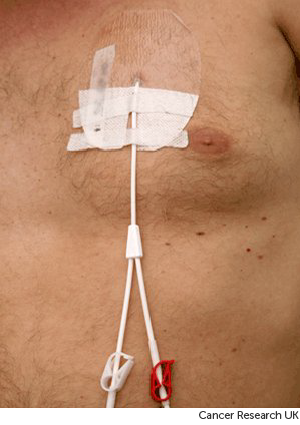Central lines
You might have chemotherapy into the bloodstream through a long flexible plastic tube called a central line.
They are called central lines because they end up in a central blood vessel in your chest, close to your heart.

There are different types of central line:
-
acute central line
-
tunnelled central line
-
peripherally inserted central catheter (PICC line)
-
portacath or totally implantable venous access device (TIVAD)
This page is about acute and tunnelled central lines.
Acute central lines
An acute central line goes in through a vein in your neck. It is used for short term treatments. You might have one if you need treatment urgently or it is difficult to find a vein for a cannula.
Skin tunnelled central lines
A skin tunnelled central line goes in through your chest. It goes under your skin and into a large vein by your collarbone. The only bit you can see is the length of line that hangs out of the small entry hole in your chest.
At the end of the length of line that you can see, there are connection ports where the nurse attaches your chemotherapy. The connection ports are kept closed with caps.
This is a picture of a skin tunnelled central line in place.

Before a skin tunnelled line is inserted, you have a local or general anaesthetic. Sometimes doctors use continuous x-rays as they put the tube in, so they can see where it’s going. Your doctor may want you to have an x-ray afterwards to make sure the end of the tube is in the best place.
When the tunnelled line is in, they will stitch it in place or put special dressings over it, so it can't come out. The stitches are removed after about a week. There is also a small cuff on the line, which is under the skin and holds it in place. You can move about normally. It won't come out while you’re sleeping or dressing.
The tunnelled line can stay in your vein for many months. So you won't need to have needles into your hand or arm each time you have your chemotherapy treatment.
Your doctor and nurse can also take blood from the line for tests. They can also use the line to give you fluids or other treatment such as antibiotics if you need them.
The video below shows how a tunnelled central line is put in. It is 1 minute and 47 seconds long.
How a tunnelled central line is put in
You lie on a tilted bed with your head turned to the left and lower than your feet.
The doctor cleans your skin with antiseptic solution and injects a local anaesthetic into your neck and chest.
They then put a needle through your skin and into a vein and thread a guide wire through the needle into your vein.
Next, they make a small cut in your neck and chest and, using a tunneler put the line through the cut in your chest passing it under your skin and out of the cut in your neck.
Then they remove the tunneler.
Next, they put a covered dilator over the guide wire into your vein.
Then they remove the guide wire and dilator leaving the cover in your vein.
The doctor feeds the line into the cover in your vein and then removes the cover.
Next, they take blood to check it is in the correct place then stitch the cuts in your neck and around the line and put dressings over them.
Finally, you have an X-ray to check the position of the line. The line is then ready to use.
Possible problems
Sometimes problems can happen with tunnelled central lines:
-
you may get an infection
-
the line may get blocked
-
a blood clot can develop
-
the line may split, but this is very rare
Your nurse will test your tunnelled central line each time they use it. They will check for blood return and inject it with salt water (saline). This is called flushing. It’s very important to tell your nurse if you experience pain as the line is flushed or during chemotherapy. This could mean the line has split.
If you are not having treatment regularly, you or your nurse needs to clean and flush the line weekly. This will keep it clear and stop any problems developing. It is flushed with  and saline to clean the line and prevent clotting. The nurses on the ward can teach you or your carer how to do this. Your district nurse can care for your line or help you at home at first.
and saline to clean the line and prevent clotting. The nurses on the ward can teach you or your carer how to do this. Your district nurse can care for your line or help you at home at first.
It’s very important to avoid getting an infection in the area where your line goes into your body. Speak to your chemotherapy nurse or doctor if you notice any redness, swelling, oozing or soreness. These could be signs of infection.
You’ll need to have treatment with antibiotics straight away if you do develop an infection. Otherwise, a doctor or nurse may have to remove the line and put a new one in.
Everyday life with a central line
You can go home with a central line in place. There are very few restrictions to your everyday life.
It’s fine to have a bath or shower. Don't let your line go under water in the bath.
Before you go home, make sure you’re confident about looking after your line. Ask the staff on the ward if you’re not sure about anything. They can arrange for district nurses to visit you at home to help with the line until you feel confident.
Contact your advice line if you have any problems at home.



